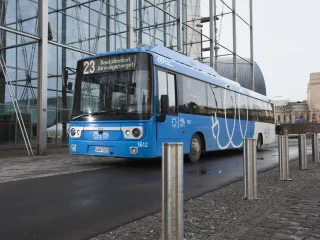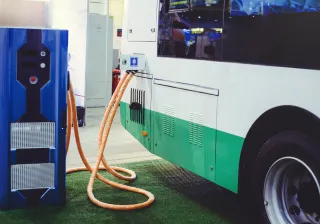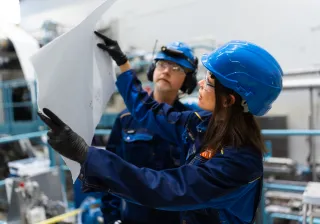While the electric bus revolution is coming, questions about the right equipment and infrastructure remain. To meet its ambitious emissions goals and for the electrification its fleet, HSL used the VTT Smart eFleet toolbox. The resulting, optimised fleet is environmentally friendly, cost-efficient and reliable.
Photo: HSL/Lauri Eriksson
Key facts
Transparent assessment of vehicles and routes
Higher cost-efficiency in planning & operations
Electrification cuts emissions of public transportation
Helsinki Regional Transport Authority, HSL, is a joint local authority responsible for organising public transport in the Greater Helsinki area. With some 370 million trips made on HSL’s transport services annually, the acquisition of new equipment is an important public investment.
HSL has an ambitious plan to cut its nitrogen oxide, fine particle and carbon emission levels by 90% by the year 2025 (compared with 2010 levels). Bold and innovative actions are required and that’s why in 2012, HSL partnered with VTT to solve the challenges in the large-scale introduction of electric buses.
Charging infrastructure requires planning
Electric buses are effective in reducing emissions and fighting climate change. In the long run, they are also cheaper to operate than traditional diesel buses. However, they also require new infrastructure.
The charging of electric buses has to be taken into account when planning routes and schedules, as poor charging planning increases operating costs.
Diesel buses are usually fuelled only during the night, as they carry enough fuel to operate the whole day. With electric buses, the batteries have to be charged during the day. Operators have to decide between two bus and battery types:
- slowly charged batteries requiring one long charge at a depot during the day
- quickly charged batteries requiring a quick charge at the bus stop after each trip.
As the temperatures in Finland can be arctic in the winter, all the equipment has to be winterproof. The wrong choice of buses, batteries and routes result in significant expenses.
Over half of the bus operating costs are staff costs, so unnecessary charging trips should be eliminated. On the other hand, the electrification of the bus fleet also requires building and placing charging infrastructure, which causes additional costs.
Finding the perfect balance between having enough charging stations so that bus drivers don’t have to drive far to charge the buses and causing additional expenditure by building too much infrastructure is difficult.
Electrification is a long-term process and usually happens gradually. At the beginning, the fleet is small, and determining the routes that benefit the most from electrification is important.
Simulations the key for fleet organisation
To overcome these challenges, HSL started using the VTT Smart eFleet toolbox. The toolbox supports organisations in planning and organising public transport.
Smart eFleet combines VTT’s research data with geographical operation environments, vehicle properties and the effect of the infrastructure to analyse the public transport system.
Through simulation, the tool provides accurate information on:
- placement and dimensioning of the fleet and charging infrastructure
- the properties, reliability and impact of different bus and battery types
- how weather conditions and geography affect the operation
- which routes benefit the most from electrification
- energy consumption
- emissions.
VTT has expertise in various fields that benefit fleet electrification, such as battery chemistry.
Optimised fleet reduces costs and emissions
HSL has had electric buses in commercial use since autumn 2019. Commercial use has proved that the simulations provided by VTT Smart eFleet have been accurate.
The VTT Smart eFleet toolbox makes the planning of fleet electrification transparent. VTT is an independent agent that has its own test facilities and software to guarantee uncompromised results.
The simulations have supported HSL in using the right equipment on the right routes. The optimised electric fleet is cheaper than a fleet running on diesel and currently shows savings potential of up to 0.1 euros per kilometre.
The toolbox has significantly increased the energy efficiency of HSL’s fleet while cutting emissions. This helps HSL reach their goal of reducing emissions and also encourages energy companies to produce more environmentally sustainable diesel to compete with the electric solutions.
The routes and the infrastructure for electric buses are well planned, which enables higher reliability and lower staff costs.
An independent long-term partner
HSL and its predecessors have collaborated with VTT for decades.
As a partner, VTT is as reliable as they come. Working with vehicle manufacturers, it is vital to have an independent partner to assess the equipment. VTT has broad expertise and they embrace the constant change of methods in public transport. Without VTT the project would have taken much longer and we would have made more mistakes along the way,
In the future, VTT and HSL aim to share the charging infrastructure of electric buses with other external users. This would expand the environmental impact of fleet electrification even further.










